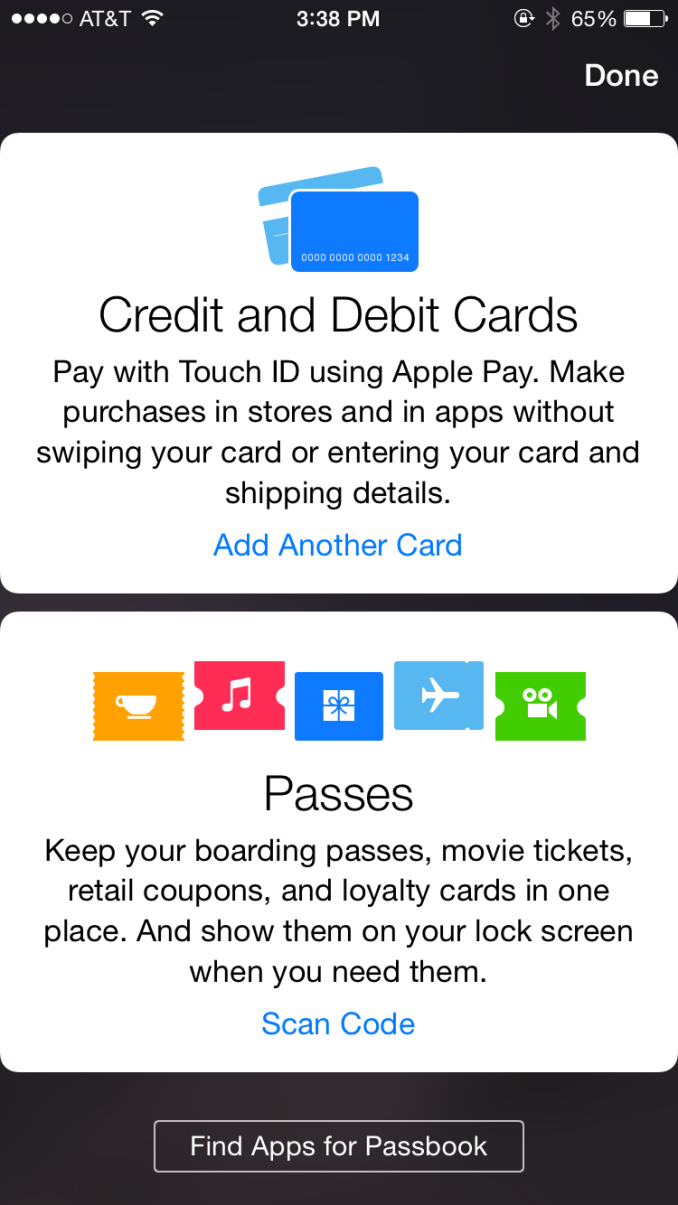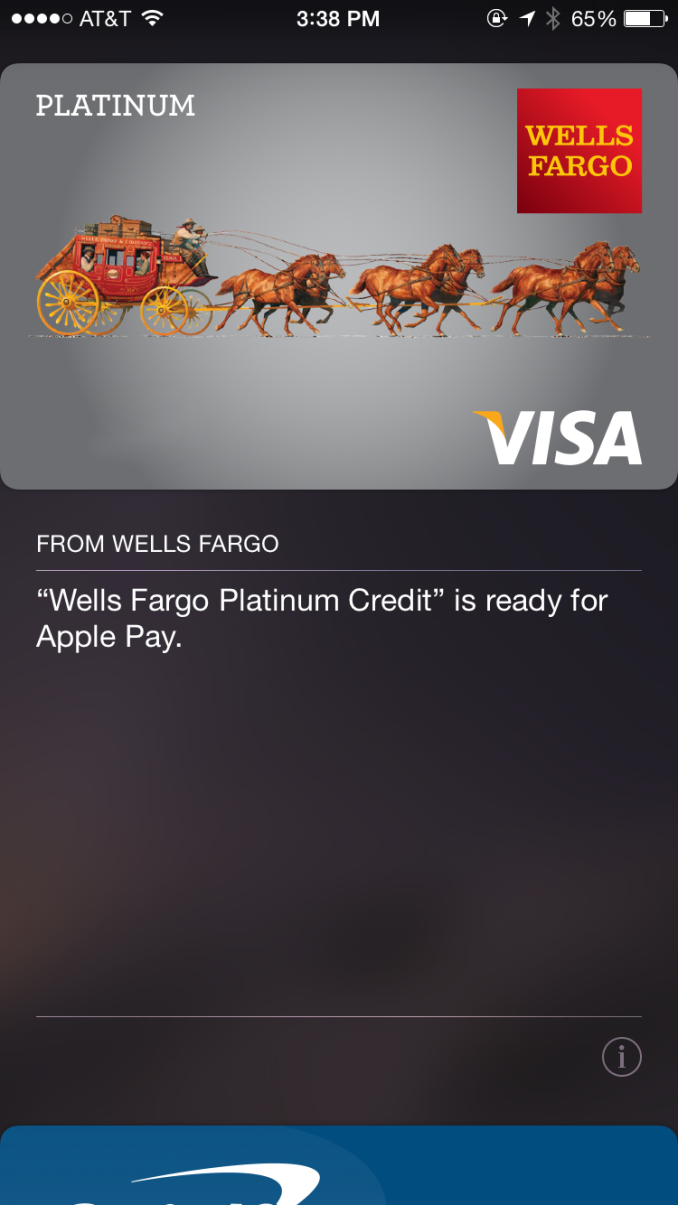A Look At OS X Yosemite And iOS 8.1
by Brandon Chester on October 27, 2014 8:00 AM ESTApple's Foray Into Payments
Apple has made two announcements this year that show an expansion into areas outside of the technology industry. The first was Apple Watch, which is most definitely a technology product but looks positioned against the current premium watch industry just as much as against current smartwatches on the market. The second was Apple's foray into the payment industry, Apple Pay. While Apple Watch won't be around until next year, Apple Pay is here right now with one caveat. Apple Pay currently only works in the United States, or more specifically, only with a credit card issued by a United States bank. However, the service will eventually be expanded to support cards issued by banks in other countries.
How Apple pay works is fairly straightforward, that's the entire point of it. If the region on your device is set to the United States, the passbook app will contain a card that allows you to add a credit or debit card. You can then either type your info in, or use your camera to get the information from the card. Once the card is verified by your bank, you will have a card that appears in passbook and you're ready to start using Apple Pay. From the user's perspective, Apple Pay is simple and easy to use. But what goes on behind the scenes to keep everything secure can be quite complicated.
Security
The first thing to know is that your credit card information is never stored on the phone. Upon adding a credit card, the information is encrypted and sent to the appropriate issuing bank which confirms that the card is valid. A token is then sent back to the iPhone and stored in the secure element, which is essentially just an internal smart card chip. This token, not your credit card number, is what is used during payments. Apple's marketing and technical material refers to it as a Device Account Number. The token itself resembles a credit card number, but the only similarity between it and your card is the 4 digits on the end.
The use of tokens is where much of the security of Apple Pay comes from. By removing the actual credit card number from the equation, the merchant you're paying never gets to see your credit card number, security code, or your name. The token presumably is also only linked to the actual credit card via some database held by the bank, rather than some sort of equation that could be reverse engineered. This means that even in the event where a merchant is hacked and your token number shows up, it is entirely useless because it does not function as a credit card and is tied to the iPhone it was used on.
Beyond the overarching security, there's additional security at the time of payment. It begins with the use of Touch ID for authorizing payments. Although Touch ID launched with the iPhone 5s which does not have the necessary NFC hardware to use Apple Pay, I believe that this sort of service was the original goal when Touch ID was first being created. Paying with Apple Pay requires using Touch ID to verify your fingerprint. This prevents anyone from making purchases using your iPhone if it is lost or stolen.
One thing to note is that Apple Pay is not just a service for making purchases in stores. It also works for making purchases at online retailers than integrate it into their applications. All the security features that I've described apply to both in-store and online purchases, so there's no compromises on either side.
Going Forward
Making Apple Pay successful is going to take a lot of work on both Apple's part and on the part of retailers. Currently the service only works with cards from US banks, leaving out the rest of the world. Apple needs to expand the service much quicker than competitors have done so with theirs. For example, Google Wallet remains a US only service over 3 years after its initial launch. Apple Pay is not going to achieve success if it ends up in the same situation. Apple has given no timeframe for expansion to other countries, but if the iPhone 6 and 6 Plus get replaced by newer models before Apple Pay expands outside the US it will be a worrisome situation.
Apple also needs to convince retailers to support the service. The list of supported merchants on the Apple Pay section of their website has grown since its initial launch, and if Apple Pay is ever going to be a viable way to make everyday purchases that list needs to continue to grow. Work by banks to increase adoption of NFC capable terminals will also speed up this process, as Apple Pay works with existing NFC enabled checkouts. Apple also faces resistance from retailers that are partnered with other payment systems. Recently there have been reports that merchants who support the CurrentC mobile payment standard are disabling NFC on the payment terminals in their stores to block Apple Pay. I don't believe this will be an issue in the long term because consumers will realize when companies are prioritizing their own agenda over the customer's experience and they'll go to other retailers. If Walmart won't support Apple Pay and a customer wants to use it, they'll just go to Target instead.
As someone who doesn't live in the United States, I'm hopeful that the service will expand to Canada before this iPhone becomes obsolete. There are many obstacles in the way, but Apple appears to have put more effort into working with banks and merchants to get the service off the ground than any of the other mobile payment services we have today. How things play out will only be revealed with time.












173 Comments
View All Comments
ant1pathy - Tuesday, October 28, 2014 - link
> $1399 lenovo y50Form factor and battery life. Compare the two:
Y504k: 15.24" x 10.37" x 0.94" 5.29lbs | Up to 4 hour(s) battery
rMBP: 14.13" x 9.73" x 0.71" 4.46lbs | Up to 8 hours wireless web 95watthour
monopodman - Wednesday, October 29, 2014 - link
Yep, rMBP also has Thunderbolt 2 merged with Displayport 1.2 (guaranteed 4K@60hz support for external screen, not sure if HDMI in Lenovo is up to the task, because even HDMI 1.4 supports only 4K@30hz which is .... useless most of the time). I'm actively using Thunderbolt for data connectivity (faster and lower latency than USB3.0, more power (10W) for large external SSDs, universal dock-stations etc.)....Morawka - Wednesday, October 29, 2014 - link
how many people are going to drive a 4k display off their laptop? not manyzogus - Wednesday, October 29, 2014 - link
Considering the internal display of the laptop in question is 4K, the answer is "more than you seem to think."Ratman6161 - Monday, November 3, 2014 - link
For a lot of people the $600 Best Buy laptop or even, yes, the $400 best buy laptop are good enough for their needs. Yes, at the higher end the prices work out to often being nearly the same for comparable configurations. The thing is that for the person for whom a low end configuration is good enough, there is no "comparable configuration". Apple doesn't even try to play in that market - so those folks are going to go Windows.Also, why should Apple focus on making OSX and iOS play together more seamlessly? The numbers of iOS users are several orders of magnitude greater than those using a Mac. So what are all those iPad and iPhone users using on their desktop or laptop? The answer for the vast majority is...Windows. So might Apple actually be better off focusing their attentions on making iOS work seamlessly with Windows? There will be vastly more people out there using Windows + iOS than there are using OSX + iOS...just saying...
sbuk - Sunday, March 22, 2015 - link
That's some pretty advanced stupid right there...Anangrypotato1 - Monday, October 27, 2014 - link
Can you tell me why they do it other than for profit? I bought a 2013 MBA, and I see no reason why I shouldn't be allowed to replace the RAM, CPU, or whatever else I want to.Kristian Vättö - Tuesday, October 28, 2014 - link
Soldering the parts onto the logic board saves space, which is crucial for a laptop like MBA.ant1pathy - Tuesday, October 28, 2014 - link
The 2013 MBA isn't possible while also providing easy user accessibility. Form factor has consequences.monopodman - Thursday, October 30, 2014 - link
Here's why Apple use soldered RAM:1) it saves space (<- no room needed for connectors)
2) easier routing (-> less space on motherboard, lower resistive and capacitive load on IMC)
3) better performance (<- lower latency due to lower RC time constant, which is good in a laptop that usually runs hotter than desktop or DTR-sized laptop)
4) when maxed out to 16GB, there's no need to upgrade (it probably won't be possible to use 2x16gb sticks regardless)
5) repairability is a deliberate compromise
6) extra markup for Apple from "power users", who otherwise would buy 3rd party RAM
7) many ultrabook manufacturers are switching to soldered RAM
There're almost no laptops with replaceable CPU because
1) assembly becomes thicker
2) only oriented on power users (removing heatsink/thermal compound isn't trivial)
3) isn't good for marketing